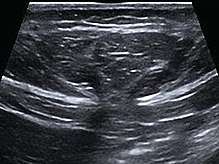Epigastric hernia

Abdominal ultrasound of a midline epigastric hernia.[1]
An epigastric hernia is a type of hernia which may develop in the epigastrium (upper, central part of the abdomen). Epigastric hernias usually appear in adults.
Unlike the benign diastasis recti, epigastric hernia may trap fat and other tissues inside the opening of the hernia, causing pain and tissue damage.[2]
Risk factors
Diagnosis
Computed tomography scans of the suspected areas with intravenous contrast can assist in diagnosis.[3]
Treatment
Symptomatic epigastric hernias are repaired with surgery.[2] Even if they are asymptomatic, they can be surgically corrected for cosmetic reasons. In general, cosmetic surgery on infants is delayed until the infant is older and better able to tolerate anaesthesia.
See also
References
- ↑ Bedewi, Mohamed Abdelmohsen; El-sharkawy, Mohamed (2017). "Imaging of Hernias". doi:10.5772/intechopen.69163.
- 1 2 3 Norton, Jeffrey A. (2003). Essential practice of surgery: basic science and clinical evidence. Berlin: Springer. p. 350. ISBN 0-387-95510-0.
- ↑ Toms, A. P.; Dixon, A. K.; Murphy, J. M.; Jamieson, N. V. (October 1999). "Illustrated review of new imaging techniques in the diagnosis of abdominal wall hernias". The British Journal of Surgery. 86 (10): 1243–1249. doi:10.1046/j.1365-2168.1999.01211.x. ISSN 0007-1323. PMID 10540124.
This article is issued from
Wikipedia.
The text is licensed under Creative Commons - Attribution - Sharealike.
Additional terms may apply for the media files.